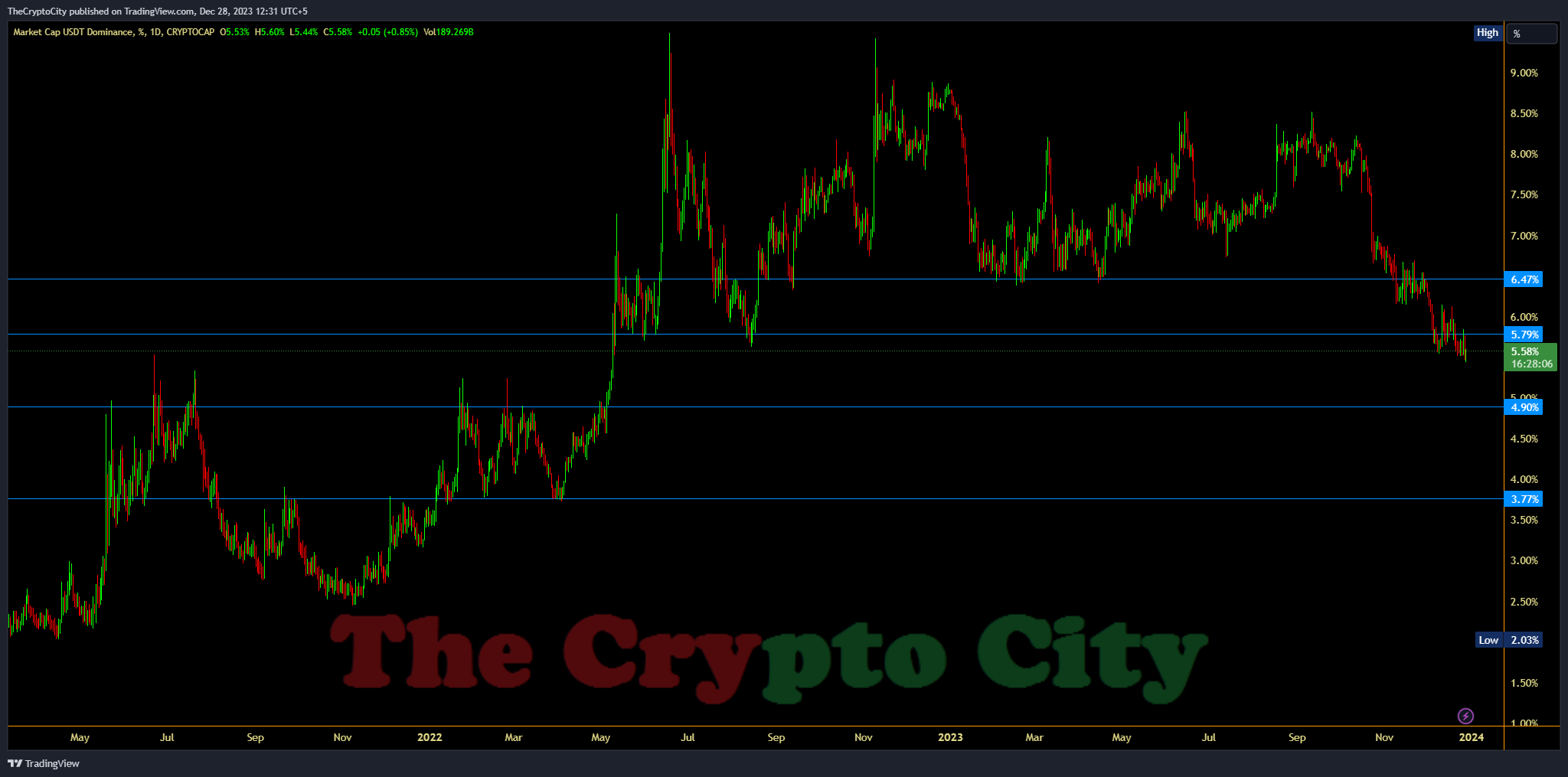Charting the Stablecoin Market Course for Q1 2024
The stablecoin market is currently steering the crypto landscape with a sense of stability and growing confidence. As we delve into the metrics, it becomes evident that the altcoin rally is far from over, indicating a robust crypto market for Q1 2024.
One of the key indicators, the dominance chart, vividly portrays that the surge in altcoins is still underway. This sustained momentum can be attributed to the crypto market’s overall positive trajectory, initiated around late September. Notably, Bitcoin [BTC] found significant demand at the $26k level, setting off a rally that resonated throughout the market and instilled a renewed sense of assurance among investors.

Examining relevant stablecoin metrics, AMBCrypto has identified a noteworthy correlation between these metrics and investor confidence. The question looming is whether this winning streak will persist into the new year, shaping the trajectory of the crypto market in Q1 2024.
The upswing in stablecoin usage and adoption is a crucial aspect to consider. On-chain metrics, including exchange reserve, inflows, circulating supply, and active addresses, provide valuable insights. AMBCrypto’s analysis reveals that the circulating supply of ERC20 stablecoins has experienced a noticeable uptick over the past month.
Comparing this trend to historical data, a similar occurrence was observed in February/March 2023. Subsequently, there was a downward trend in supply during the intervening period, potentially influenced by various factors.
For instance, during times of market uncertainty or a lack of a strong uptrend, stablecoins might be staked to earn rewards. Alternatively, users could be locking their stablecoins in DeFi platforms for loans or engaging in yield farming. Another plausible scenario is users holding stablecoins in reserve, strategically anticipating a significant market downturn before making entry moves.

Source: CryptoQuant
The surge in circulating supply since mid-November signifies a notable uptick in the utilization of stablecoins, suggesting increased engagement in day-to-day transactions as well as trading and speculative ventures within the crypto market. This surge in circulating supply is a positive indicator of heightened usage, reflecting the adaptability and acceptance of stablecoins in various financial activities.
This increased usage is a positive outcome for the stablecoin market, showcasing its growing relevance in facilitating transactions and serving as a medium of exchange within the broader crypto ecosystem. As stablecoins play a pivotal role in providing stability amid the volatile crypto market, their heightened circulation is indicative of a positive trend.
The speculation surrounding stablecoins serves as a noteworthy indication of market participants’ growing confidence in crypto assets. This sentiment is further reinforced by examining the rising Open Interest not only in Bitcoin but also in various other assets, signaling a prevailing bullish market sentiment in recent weeks.
Furthermore, the active addresses count has exhibited an upward trend since late September, with the 7-day Simple Moving Average offering a clear visual representation of this positive trajectory. The simultaneous uptrend in both supply and unique active addresses underscores a flourishing market activity and adoption.
In essence, the increasing circulating supply, coupled with a rise in active addresses and a surge in Open Interest, paints a picture of a dynamic and thriving crypto market. These metrics collectively point toward a positive outlook for the stablecoin market, reflecting not only increased usage but also a broader acceptance and confidence in crypto assets among market participants. As we chart the course for Q1 2024, these indicators set the stage for continued growth and evolution within the crypto landscape.

Along with this, exchange inflows have been trending increasing since mid-October. Because an influx of stablecoins to exchanges provides accessible liquidity, it was a sign of increased buying pressure in the crypto market.

Source: CryptoQuant
As we thoroughly examine the various metrics, it becomes increasingly evident that the overall sentiment in the market is decidedly bullish. This optimism, however, encounters a nuanced perspective when scrutinizing the stablecoin exchange inflow. Notably, there was a marked and abrupt decline in stablecoin exchange inflow after the 17th of December, a phenomenon that stands in contrast to the continuous upward trajectory observed in other key metrics.
This divergence prompts a critical question: Does the sharp drop in stablecoin exchange inflow imply that buying pressure is beginning to wane? The answer to this question is pivotal in understanding the nuanced dynamics of the current market conditions.
In search of deeper insights, technical analysis of stablecoin dominance emerges as a valuable avenue for exploration. Tether (USDT), being the foremost stablecoin by market capitalization, assumes a central role in this analysis. Notably, Tether’s 24-hour volume, as reported by CoinMarketCap, is nearly 12 times higher than the next stablecoin on the list, USD Coin (USDC). This substantial difference in volume positions USDT as a dominant force within the stablecoin landscape.
The USDT dominance chart, therefore, emerges as a potent proxy for gauging the performance of stablecoins and providing valuable foresight into what the coming months may have in store for the market. The dominance chart holds the potential to unravel trends and patterns that might not be immediately apparent in individual metrics.
The recent divergence in stablecoin exchange inflow raises intriguing questions about the sustainability of buying pressure. To gain a more comprehensive understanding, a nuanced exploration through technical analysis, particularly focusing on the dominance chart of Tether (USDT), could unveil valuable insights and shed light on the potential shifts in the market landscape.

The USDT Dominance was in a steep decline. It has dropped from 8% on October 16 to 5.62% at press time. Furthermore, the 5.79% level, which was a support level approximately 18 months ago, has now become a resistance level.
The next long-term support to the south is at 4.9%. It is uncertain how much money could be added to the cryptocurrency market capitalization. However, altcoin investors should expect to take profits if USDT’s dominance falls below 4.9%.
Conclusion
The analysis of stablecoin metrics paints a comprehensive picture of the crypto market’s dynamics heading into Q1 2024. The bullish trends in various indicators, such as circulating supply, active addresses, and overall market capitalization, reflect a positive sentiment and growing confidence among investors. However, the recent divergence in stablecoin exchange inflow, coupled with the evolving landscape of USDT dominance, introduces nuanced considerations and potential challenges.
The downward trend in USDT dominance, sliding from 8% on October 16 to 5.62% at present, raises questions about the sustainability of buying pressure and indicates a shift in market dynamics. The transformation of the 5.79% level from historical support to resistance further underscores the evolving nature of stablecoin preferences. As the market navigates these changes, investors, particularly in altcoins, should closely monitor the potential test of the 4.9% support level, which could influence market reactions and prompt strategic decisions.
In navigating the crypto landscape for Q1 2024, the interplay of these factors underscores the importance of adaptability and informed decision-making. As the market continues to mature, staying abreast of evolving trends and leveraging insights from technical analysis will be essential for investors seeking to optimize their positions and capitalize on emerging opportunities. The dynamic nature of the crypto market invites a proactive approach, and strategic planning will be paramount for success in the coming months.
FAQ’s
**1. What are the key indicators suggesting a bullish trend in the crypto market for Q1 2024?**
The dominant factors pointing towards a bullish market include the surge in altcoin dominance, the rise in crypto market capitalization since September, and the notable increase in stablecoin metrics, reflecting heightened investor confidence.
**2. How has the circulating supply of stablecoins changed recently, and what does it imply for market dynamics?**
The circulating supply of ERC20 stablecoins has shown an uptick since mid-November, indicating increased usage. This surge in supply may be attributed to various factors such as staking for rewards, participation in DeFi platforms, or holding stablecoins in reserve.
**3. What is the significance of the drop in stablecoin exchange inflow after December 17th?**
The sudden decline in stablecoin exchange inflow, despite other metrics rising, raises questions about the sustainability of buying pressure. This divergence prompts a closer examination of market dynamics and potential shifts in investor sentiment.
**4. How does the technical analysis of USDT dominance provide insights into the stablecoin market?**
The USDT dominance chart reveals a strong downtrend, sliding from 8% on October 16 to 5.62% at present. The 5.79% level, previously a support, now acts as resistance. Technical analysis of USDT dominance serves as a valuable tool for understanding the performance of stablecoins and predicting future market trends.
**5. Why is the 4.9% level crucial in the context of USDT dominance, and how might it impact the crypto market capitalization?**
The 4.9% level is identified as the next long-term support for USDT dominance. A breach of this support could have implications for the broader crypto market capitalization. Understanding this level is essential for anticipating potential shifts and planning investment strategies.
**6. How does the performance of Tether (USDT) compare to other stablecoins, particularly in terms of market capitalization?**
Tether (USDT) stands out as the most popular stablecoin with a market capitalization significantly higher than other stablecoins. Its dominance chart provides insights into the overall performance of stablecoins and can serve as a proxy for predicting market trends in the coming months.
**7. How should altcoin investors interpret the trends in stablecoin dominance, especially in light of potential testing of the 4.9% level?**
Altcoin investors should closely monitor stablecoin dominance, especially if it approaches the critical 4.9% support level. A breach of this level could impact altcoin markets, prompting investors to consider profit-taking strategies and adapt their investment plans accordingly.

